
table of contents
- Location
- floor
- sorts
- plants
- to water
- Fertilize
- Cut
- Multiply
- School
- Overwinter
- Diseases and pests
Profile and care information open +conclude -
- Flower color
- yellow Red
- Location
- Partial shade, sunny
- Heyday
- April May
- Growth habit
- upright, expansive
- height
- up to 35 meters high, cultivars up to 10 meters
- Soil type
- loamy, gritty
- Soil moisture
- moderately dry, moderately moist, very moist
- PH value
- neutral, slightly acidic, acidic
- Limescale tolerance
- Calcium intolerant
- humus
- low in humus
- Poisonous
- no
- Plant families
- Pine family, Pinaceae
- Plant species
- Conifers, potted plants, ornamental trees
- Garden style
- Park, rock garden, pot garden
The Weymouth pine originally comes from the temperate regions of America and also thrives very well in Central Europe. Anyone who opts for this tree, which is also called strobe, based on the botanical name, should choose a good location from the start, because it is a life decision. The white pine can live for several hundred years and reach considerable heights. Due to its robustness, this type of pine is on the advance in Europe.
Location
Due to the great height and the considerable diameter that the tree can reach, a location should be chosen where the Weymouth pine does not interfere even as an adult tree. Locations right next to the house or on the south side, where it creates a lot of shadow over your own house, are therefore unsuitable.
Compared to other types of pine, the white pine has a taproot system and is very well anchored in the ground. It therefore does not require any wind protection - on the contrary, it is in turn very suitable as a wind protection in the area of garden edges. As a young tree, it also benefits from a shady place. This prevents drought, for example, from slowing their growth.
In general, the strobe benefits from a slightly damp location and dry locations are particularly troublesome in summer. It is also sensitive to highly compacted soils and air pollution. Nevertheless, it sometimes develops well in urban areas, where it is often used as a park tree, albeit much more slowly than trees in locations with good air quality.
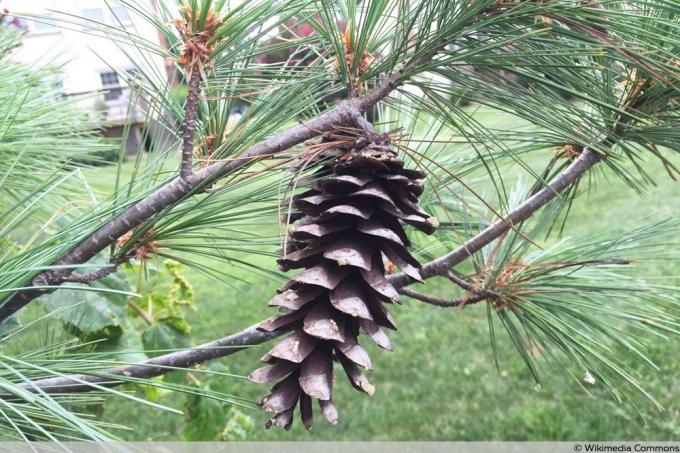
Source: Famartin, 2015-08-07 17 35 09 Eastern White Pine cone in the Franklin Farm section of Oak Hill, Virginia, Edited by Gartenlexikon.de (MKr), CC BY-SA 4.0
floor
Pinus strobus needs a loose and permeable soil and that also in deeper layers. The soil should be constantly moist and therefore be able to store moisture well. Waterlogging is not an advantage, even if the Weymouth pine can withstand a lot of moisture for a short time. In addition, the soil should be rich in nutrients, which should also be taken into account during regular maintenance.
What Pinus strobus cannot tolerate is very acidic soils. The pH value should be neutral to a maximum of slightly acidic. In addition, it hardly tolerates any lime. In regions with very lime-rich soils, low-lime, nutrient-rich soil should therefore be incorporated regularly, especially in the first few years. In addition, rainwater should only be used for watering.
sorts
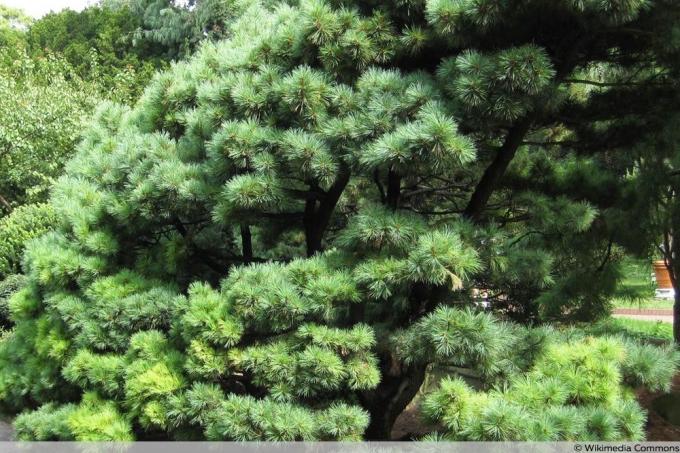
Source: Raffi Kojian, Pinus strobus radiata - Gardenology.org-IMG 0695 bbg09, Edited by Gartenlexikon.de (MKr), CC BY-SA 3.0
There are now some cultivated forms of the original form of Pinus strobus that do not differ in terms of care, but have a slightly different appearance and a slightly different growth habit. In addition, some varieties have been deliberately bred for weak growth, which means that they are sometimes even used as ground cover, which can reach a height of around one meter.
Overview of varieties
- Brevifolia: up to 2 m in height, short needles, densely branched, broad cone shape
- Minima: up to 1.2 m in height, blue-green color, loose crown
- Fastigiata: up to 10 m in height, long needles, blue-green color, columnar
- Kruger Liliput: approx. 1 m high, short stiff needles, green-gray color
- Umbraculifera: up to approx. 1.5 m high, hemispherical shape
- Pendula: up to 4 m high. columnar with hanging branches, short blue-green needles
- Radiata: up to 6 m high, conical growth, very soft blue-green needles
Compared to the wild form of the white pine, cultivars with weaker growth are also suitable for smaller gardens. The disadvantage is that cultivated forms are not as robust as the wild forms. The young trees in particular need significantly more protection in the first few years. They are less sensitive to frost, but only cause problems for prolonged drought in summer.
plants

When planting the Weymouth pine for the first time, it is important to ensure that the soil is optimally prepared. The soil should be loosened up to a depth of at least two meters. Granules that store sand and water, such as basalt rock or expanded clay, are then worked into the soil. There are no special instructions for planting the Weymouth pine and it is transplanted like any other conifer.
The planting hole itself should be at least twice as large as the root ball of the young tree. If there is a risk of vole bite, the root ball is also wrapped with a wire. After the tree has been placed in the planting hole, the hole is filled with nutrient-rich soil. Compost soil, which in turn has been mixed with a water-storing granulate, is suitable for this. The soil is pressed lightly and then poured thoroughly.
Note: Varieties with a columnar or cone-shaped habit always required a stake in the first two to three years.
The ideal planting time is frost-free spring or autumn. It is an advantage if a time is chosen at which persistent precipitation is announced, because even in autumn or In spring, young trees in particular are sensitive to drought. In the first few years it is an advantage if there is underplanting for varieties that are not intended as ground cover. Ideal for this is z. B. the little evergreen.
to water
In the first three to four years, the Weymouth pine is much more sensitive to the lack of precipitation. As a rule, it does not die off immediately, but it slows its growth and it can happen that its needles become discolored or that it even throws them off as a self-protection.
Instructions for pouring
- Use rainwater
- water the earth within a radius of 2 m
- pour penetrating
Fertilize
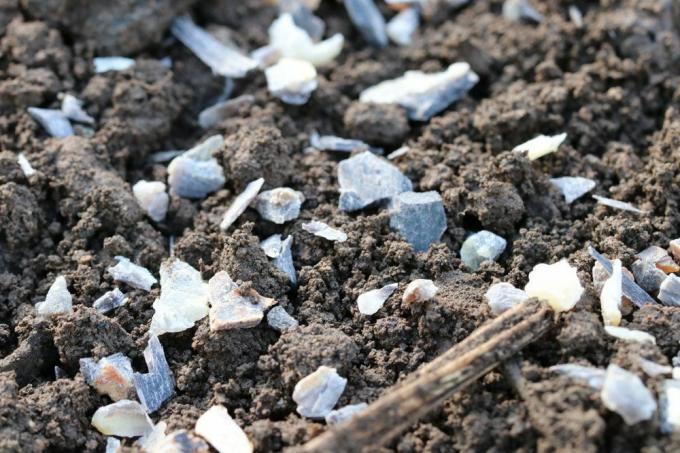
The white pine has a medium to high nutritional requirement and throughout its life. Fertilizer should therefore be incorporated regularly in spring and winter. The following are suitable as fertilizers:
- ripe compost
- Horn shavings
- Solid fertilizer (e.g. B. Manure pellets)
- Special fertilizer for conifers
In the first few years, young trees should also be provided with liquid fertilizer once a month. A commercially available fertilizer for green plants is sufficient for this.
Cut
When caring for the Weymouth pine, regular pruning is usually not necessary. However, if it has become too big in diameter or if it has damaged branches, you should be very careful when pruning. As with other pines, it also secretes resin to close wounds. So that the plant is not additionally stressed, it should not be pruned until autumn.
Instructions for pruning
- Select branches
- Remove thin branches with bypass scissors
- Cut off thicker branches with a sharp saw
- Provide larger interfaces with a wound closure
Native pine plants usually secrete sufficient resin themselves and do not require any additional wound closure. The strobe does not have that much resin production and is also susceptible to some diseases and pests. Therefore, especially larger wounds on the Weymouth pine should be closed with a resin-based wound closure.
Multiply
The usual form of propagation is by sowing. The white pine is also able to develop seeds here if a suitable pollinator is nearby. The seeds can be collected in autumn when the cones fall off. The cones should be kept in a warm place so that the seeds can detach from them. This will open them up and the seeds of Pinus strobus can easily be knocked out.
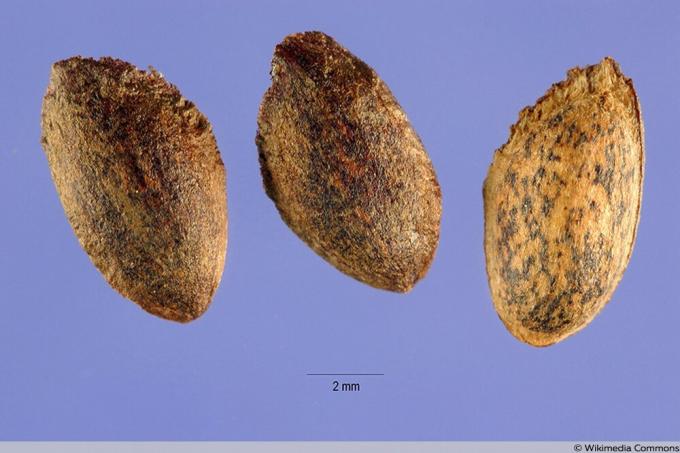
Source: Steve Hurst @ USDA-NRCS PLANTS Database, Pinus strobus seeds, Edited by Gartenlexikon.de (MKr), CC0 1.0
In order for the seeds to germinate, they must first be stratified. Instructions for stratifying:
- Wrap the seeds in moistened kitchen paper
- Put the parcel in a freezer bag
- Cut smaller air holes in the bag
- Put seeds in the refrigerator for three weeks
- Check the seeds occasionally and moisten kitchen paper again
After the seeds are stratified, they can be planted. The strobe is a light germ and for sowing is simply scattered and lightly pressed. Ordinary seed compost can be used as the substrate. The Weymouth pine needs little maintenance until the first seedlings have developed. The seeds just need to be kept constantly moist.
After small trees with the first needles have developed, the seedlings can be separated. Another culture can take place in pots in the first few months, but the trees can also be planted directly in the open ground in spring. However, there they need additional protection and, above all, care must be taken to ensure that the soil does not dry out.
School
In order for healthy and strong trees to develop from them, it is necessary to school the trees. The aim of the schooling is that the root ball remains compact. Therefore, the trees are all dug up again and again for the first four to five years. Unhealthy roots are removed and very long roots are shortened. This promotes a compact root ball and after around five years the trees come to their final location.
Note: In addition to propagation via seeds, some varieties can also be propagated via cuttings and subsets. The chances of success with these forms of propagation are, however, significantly lower than with seeds and this is why this is only practiced in professional cultivation.
Overwinter
The Weymouth pine is hardy or hardy. frost-resistant and therefore does not need any protection from the cold. Nevertheless, winter can be a problem for the white pine. In the case of varieties with spreading branches, there is a risk of snow pressure, and the needles and shoot tips are great food for deer and rabbits in winter. In very harsh winter months, they even go to the bark of the strobe. Therefore, it should be protected against browsing in autumn.
Instructions for winter protection
- Wrap the trunk of young trees with a wire mesh
- Remove widely hanging branches or, if necessary, raise them with a support
- Shake off the branches after heavy snowfall
If the snow is very deep in winter, deer can still reach the lowest branches. If it is no longer possible to raise the branches with supports, something should be shoveled around the Weymouth pine so that it is not eaten by deer.
Diseases and pests
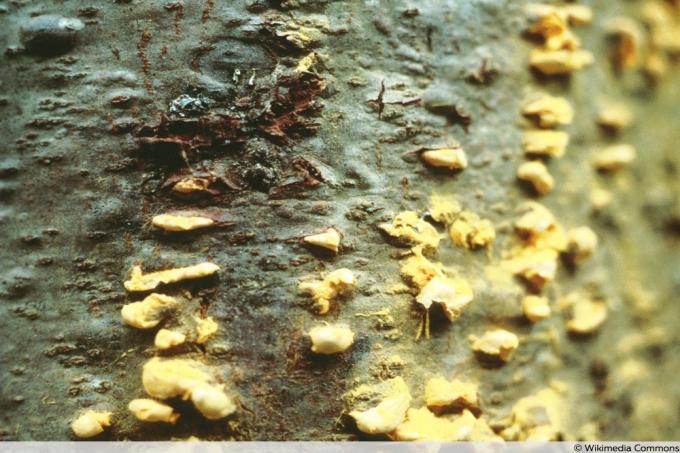
Source: US Forest Service photo [1] [Public domain], Cronartium ribicola 1, Edited by Gartenlexikon.de (MKr), CC0 1.0
Important pests and diseases:
- Straw rust
- Stem rot
- Pine fire sponge
- Dark honey mushroom
- Root sponge
- Real pine weevil
- Pine shoot winder
Note: In the 1960s there was a major death of Weymouth pine caused by the fungus Cronartium ribicola. The currant acts as an intermediate host for this species of fungus and should therefore not be planted near Pinus strobus.



